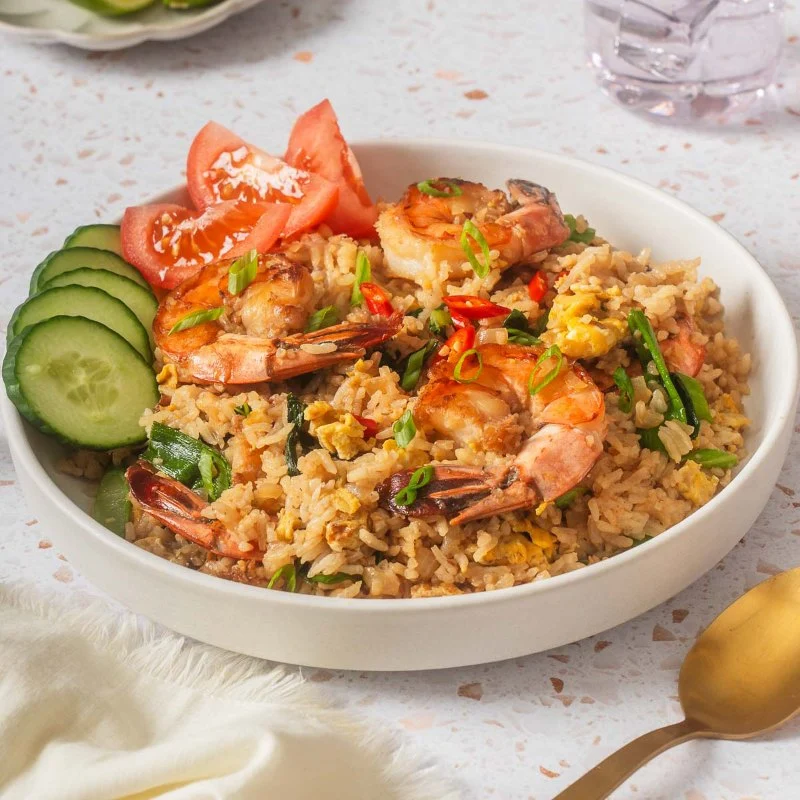
Thai Food Pairing Guide: Rice Varieties That Elevate Your Dish
- Introduction to Rice and Thai Food Pairing
- Jasmine Rice: The Fragrant Base for Thai Dishes
- Sticky Rice: Essential for Thai Street Food
- Brown Rice: A Nutritious Option for Thai Meals
- Black Rice: A Unique Flavor for Thai Cuisine
- Other Specialty Rices and Their Roles in Thai Cooking
- How to Pair Rice with Different Thai Dishes
When it comes to Thai cuisine, rice is more than just a side dish – it’s a central component that complements and enhances the rich flavors of the meal. Rice varieties in Thailand vary not only in texture but also in their ability to complement different dishes. Understanding which rice pairs best with specific types of Thai food can elevate your dining experience. This guide will take you through the best rice varieties to pair with your favorite Thai dishes and help you make the most of your Thai culinary adventures.
Jasmine Rice: The Fragrant Base for Thai Dishes
Jasmine rice is the most popular rice variety used in Thai cooking. Known for its delicate, floral aroma, this long-grain rice is soft, slightly sticky, and pairs beautifully with the bold flavors of Thai dishes. Jasmine rice is a staple in Thai households and is commonly served with everything from curries to grilled meats.
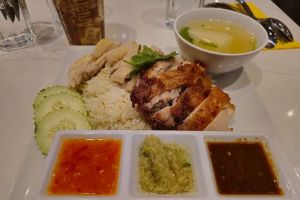
Cily Chicken Rice and Thai food
PhiladelphiaPhiladelphia CountyPennsylvania
933 Race St, Philadelphia, PA 19107, USA
Why Jasmine Rice Works with Thai Food
The aromatic fragrance of Jasmine rice adds an additional layer of depth to Thai meals, which often feature complex and spicy flavors. The rice’s natural fragrance complements the flavors of curry, stir-fries, and other richly flavored Thai dishes. Its soft, fluffy texture makes it ideal for absorbing sauces, making it the perfect base for dishes like Green Curry or Pad Thai.
Sticky Rice: Essential for Thai Street Food
Sticky rice, or khao niew, is a beloved variety of rice in Thai cuisine, particularly in the northern and northeastern regions of the country. Unlike Jasmine rice, sticky rice has a much higher starch content, making it clump together and become sticky when steamed. This unique texture makes it an essential companion for a wide range of Thai street food, such as Som Tum (papaya salad) or Laab (spicy meat salad).
Pairing Sticky Rice with Thai Dishes
Sticky rice is traditionally served with dishes that require scooping or dipping, as its sticky nature allows it to be molded into small balls for easy consumption. It’s commonly served with grilled meats like Moo Ping (grilled pork skewers) or alongside savory dips like Nam Prik (chili paste). Sticky rice’s ability to hold sauces and its chewy texture make it a perfect match for spicier or sour Thai dishes.
Brown Rice: A Nutritious Option for Thai Meals
Brown rice is a more nutritious option compared to white rice. While not as commonly used in traditional Thai cooking, brown rice is gaining popularity as people seek healthier alternatives. It retains the bran and germ, which means it is higher in fiber, vitamins, and minerals. Brown rice’s slightly nutty flavor and firmer texture can provide a wholesome base for Thai stir-fries and curries.
Why Brown Rice is Gaining Popularity
As more people become health-conscious, brown rice has become a popular choice for those looking for a more nutrient-dense option. It pairs well with vegetarian Thai dishes, such as Pad Thai or Vegetable Green Curry, where the nutty flavor enhances the natural taste of vegetables and tofu. Brown rice also holds up well in stir-fries, offering a bit more chew than traditional Jasmine rice.
Black Rice: A Unique Flavor for Thai Cuisine
Black rice, or khao mao, is a specialty rice that is often used in Thai desserts or unique savory dishes. This medium-grain rice is dark purple to black when cooked and has a slightly sweet flavor with a chewy texture. Black rice is typically served with coconut milk in Thai desserts like Khao Niew Mamuang (sticky rice with mango) or as a garnish for savory dishes.
Pairing Black Rice with Thai Dishes
Black rice can be a standout addition to both sweet and savory dishes. When paired with coconut milk and sugar, it becomes the base for Thai desserts, offering a rich, earthy flavor that contrasts nicely with the sweetness of mangoes or coconut. For savory dishes, black rice can be paired with rich sauces or used in rice salads, adding color and texture to your plate.
Other Specialty Rices and Their Roles in Thai Cooking
In addition to the more commonly known rice varieties, there are several specialty rices used in Thai cuisine that bring unique flavors and textures to dishes. These include:
Red Rice
Red rice has a nutty flavor and is slightly chewy, making it an excellent choice for Thai curries and stir-fries. It’s less commonly used but is a great addition to dishes that require a rice with a bit more character.
Brown Jasmine Rice
This rice combines the fragrance of Jasmine rice with the health benefits of brown rice. It’s a great option for those who want to maintain the traditional Thai rice flavor while adding more nutritional value to their meals.
How to Pair Rice with Different Thai Dishes
When pairing rice with Thai dishes, it’s important to consider the flavors and textures of the meal. Here are some pairing suggestions:
Pairing with Spicy Curries
For rich and spicy curries like Red Curry or Massaman Curry, Jasmine rice is the perfect choice. Its softness and ability to absorb the sauce make it a natural companion for flavorful and aromatic curries.
Pairing with Street Food
For Thai street food like Som Tum or Satay, sticky rice is the ideal accompaniment. Its texture makes it easy to pick up and dip into spicy sauces or salads, enhancing the overall eating experience.
Pairing with Vegetarian Dishes
Brown rice or even red rice works wonderfully with vegetarian Thai dishes like Pad Thai or Green Curry with Tofu, offering a heartier base that complements the flavors of fresh vegetables and tofu.
In conclusion, choosing the right rice variety can enhance your Thai dining experience. Whether you’re enjoying a fragrant curry or a savory street food snack, the right rice can elevate the dish and create a balanced, delicious meal. For more information on the best Thai food ingredients, visit Thai Food for expert recommendations and quality products.


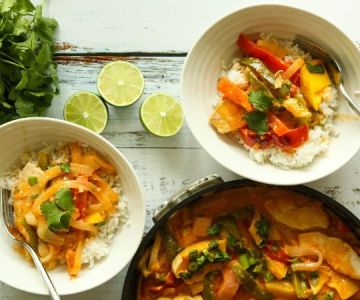

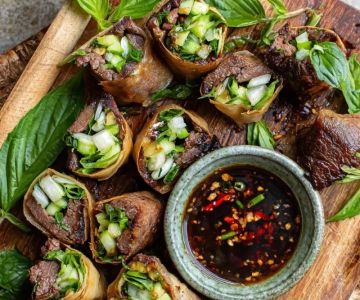



 A1 Asian Fusion4.0 (276 reviews)
A1 Asian Fusion4.0 (276 reviews) SUKH4.0 (603 reviews)
SUKH4.0 (603 reviews) When in Bangkok4.0 (2064 reviews)
When in Bangkok4.0 (2064 reviews) Asian Gourmet4.0 (108 reviews)
Asian Gourmet4.0 (108 reviews)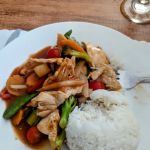 Nine Thai Cuisine4.0 (142 reviews)
Nine Thai Cuisine4.0 (142 reviews)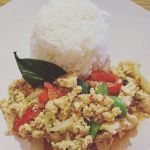 Jeen Bistro5.0 (2 reviews)
Jeen Bistro5.0 (2 reviews)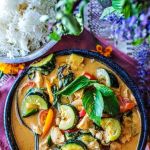 The Best Thai Food Recipes for a Mid-Week Reset Meal – Flavorful & Easy Thai Dishes
The Best Thai Food Recipes for a Mid-Week Reset Meal – Flavorful & Easy Thai Dishes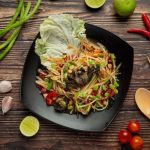 How to Make Thai Food That’s Balanced for a Healthy Lifestyle
How to Make Thai Food That’s Balanced for a Healthy Lifestyle Thai Food Ingredient Spotlight: Dried Kaffir Lime — What & How
Thai Food Ingredient Spotlight: Dried Kaffir Lime — What & How The Ultimate Guide to Thai Street Food: What to Try & Where
The Ultimate Guide to Thai Street Food: What to Try & Where Thai Food for Weekend Chefs: Bigger Batches, Bold Flavors – Your Guide to Cooking Thai at Home
Thai Food for Weekend Chefs: Bigger Batches, Bold Flavors – Your Guide to Cooking Thai at Home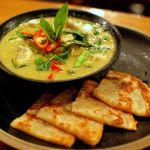 Thai Food for Late-Night Cravings: Simple, Tasty & Quick
Thai Food for Late-Night Cravings: Simple, Tasty & Quick